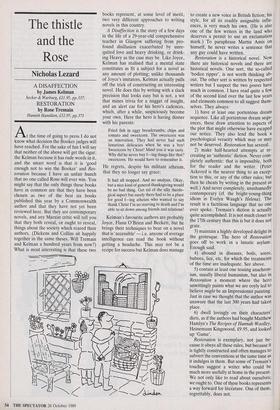The thistle and the Rose
Nicholas Lezard
A DISAFFECTION by James Kelman
Secker & Warburg, £11.95, pp.337;
RESTORATION by Rose Tremain
Hamish Hamilton, £12.95, pp.371
At the time of going to press I do not know what decision the Booker judges will have reached. For the sake of fun I will say that neither of the above will get the cigar; the Kelman because it has rude words in it, and the smart word is that it is 'good enough not to win the Booker' and Res- toration because I have an unfair hunch that no one called Rose will ever win. You might say that the only things these books have in common are that they have been chosen as two of the best six books published this year by a Commonwealth author and that they have not yet been reviewed here. But they are contemporary novels, and any Marxist critic will tell you that they both reveal, or ought to reveal, things about the society which reared their authors. (Dickens and Collins sit happily together in the same theses. Will Tremain and Kelman a hundred years from now?) What is most interesting is that these two books represent, at some level of merit, two very different approaches to writing novels in this country.
A Disaffection is the story of a few days in the life of a 29-year-old comprehensive teacher in Glasgow suffering from pro- found disillusion exacerbated by unre- quited love and heavy drinking, or drink- ing Heavy as the case may be. Like Joyce, Kelman has realised that a mental state constitutes as fit a subject for a novel as any amount of plotting; unlike thousands of Joyce's imitators, Kelman actually pulls off the trick of constructing an interesting novel. He does this by writing with a slack precision that looks easy but is not, a wit that mines trivia for a nugget of insight, and an alert ear for his hero's cadences, which, after a while, suspiciously become your own. Here the hero is having dinner with his parents:
Fried fish in eggy breadcrumbs; chips and tomato and sweetcorn. The sweetcorn was an innovation. They had never had such luxurious delicacies when he was a boy! Sweetcorn by Christ! Mind you it was tasty. Why did he never buy f—ing things like that? sweetcorn. He would have to remember it,
He regrets, despite his militant atheism, that they no longer say grace:
It had all stopped. And no analysis. Okay, but a nice kind of general thanksgiving would be no bad thing. Get rid of the silly theolo- gical aspect but surely there had to be a place for good f—ing atheists who wanted to say thank Christ I'm no starving to death and I'm able to sit down among friends and relations!
Kelman's favourite authors are probably Joyce, Flann O'Brien and Beckett, but he brings their techniques to bear on a novel that is 'accessible' — i.e. anyone of average intelligence can read the book without getting a headache. This may not be a recipe for success but Kelman does manage to create a new voice in British fiction; his style, for all its readily assignable influ- ences, is very much his own. (He is also one of the few writers in the land who deserves a permit to use an exclamation mark.) To paraphrase Martin Amis on himself, he never writes a sentence that any guy could have written.
Restoration is a historical novel. Now there are historical novels and there are historical novels. One sort, the so-called `bodice ripper', is not worth thinking ab- out. The other sort is written by respected writers but I suspect the two genres have much in common. I have read quite a few of the second kind over the last few years and elements common to all suggest them- selves. They always: 1) have at least one portentous dream sequence. Like all portentous dream sequ- ences, these draw attention to aspects of the plot that might otherwise have escaped our notice. They also lend the book a psychological veracity which may or may not be deserved. Restoration has several.
2) make half-hearted attempts at re- creating an 'authentic' diction. Never com- pletely authentic: that is impossible, both for the reader and the writer. (Peter Ackroyd is the nearest thing to an excep- tion to this, or any of the other rules; but then he cheats by writing in the present as well.) And never completely, unashamedly contemporary (cf. the bright-young-thing idiom in Evelyn Waugh's Helena). The result is a factitious language that no one ever spoke. Tremain's diction is actually quite accomplished. It is not much closer to the 17th century than this is but it does not grate.
3) maintain a highly developed delight in the grotesque. The hero of Restoration goes off to work in a lunatic asylum. Enough said.
4) abound in diseases, boils, sores, buboes, lice, etc, for which the treatments of the time are inadequate. See above.
5) contain at least one teasing anachron- ism, usually liberal humanism, but also in Restoration a moment where the hero unwittingly paints what we are coyly led to believe might be an Impressionist painting. Just in case we thought that the author was unaware that the last 300 years had taken place.
6) dwell lovingly on their characters' diets, as if the authors had bought Matthew Hamlyn's The Recipes of Hannah Woolley, Heinemann Kingswood, £9.95, and looked up 'Game'.
Restoration is exemplary, not just be- cause it obeys all these rules, but because it is tightly constructed and often manages to subvert the conventions at the same time as it indulges in them. But some of Tremain's touches suggest a writer who could be much more usefully at home in the present. We not only like to read about ourselves; we ought to. One of these books represents a way forward for literature. One of them, regrettably, does not.


































































 Previous page
Previous page